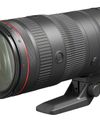
Photographers who make a living from their images often shoot in both landscape and portrait orientation for one reason: it doubles their chances of sales. This is because people buying shots for use in print are often looking for a photo that will fill a single page, which demands that it’s longer on the vertical edge, or to go across two pages, in which case it needs to be longer on the horizontal.
Tripods are primarily designed for shooting horizontally. Once you’ve set up the legs so that your tripod is level, you screw the base plate into the camera and it sits on top, with the camera’s centre of gravity directly above the tripod. To shoot vertically, ball heads have an indent which the attachment to the baseplate slots into, but that means the weight is then off-centre. Worse, the camera has moved to a new position and so we may have to recompose a shot.
When we went to shoot this windmill, overcast conditions meant the sun would only break through the clouds occasionally. We wanted the windmill to be sunlit, but by the time we’d switched orientation and recomposed, it was plunged into shade once again.
This story is from the October 17, 2019 edition of Photography week.
Start your 7-day Magzter GOLD free trial to access thousands of curated premium stories, and 8,500+ magazines and newspapers.
Already a subscriber ? Sign In
This story is from the October 17, 2019 edition of Photography week.
Start your 7-day Magzter GOLD free trial to access thousands of curated premium stories, and 8,500+ magazines and newspapers.
Already a subscriber? Sign In

CANON RF 24-105MM F/2.8L IS USM Z
A standard lens is reborn

MASTER DODGING AND BURNING
James Paterson shows you how to use these essential tools for old-school darkroom-style image enhancements

TRACKSIDE TIPS AND TRICKS
Chris Nevard explains how you can capture photorealistic images of model railways on a budget

THESE FOOD PHOTOS WILL MAKE YOUR MOUTH WATER
Pink Lady Food Photographer of the Year announces shortlist for 2024 contest

30 TIPS FOR SHOOTING SUPER SHOTS THIS SPRING
Pro photographer Simon Roy reveals his key techniques

AKASO LAUNCHES AFFORDABLE BRAVE 8 LITE ACTION CAMERA
Budget model arrives with new features include HDR and Hindsight modes

VILTROX AF 27MM F1.2 PRO
A 'pro' lens with a consumer price tag

HOW TO...MASTER SHADOWS AND HIGHLIGHTS
This powerful tool has more to it than meets the eye, and it's ideal for landscapes

PATCHWORK PORTRAITS
Mike Harris uses the Brenizer method to shoot and edit a bokeh panorama with a super-shallow depth of field

PHOTO CONTEST CELEBRATES BRITAIN'S NATURAL WONDERS
British Wildlife Photography Awards feature amazing images of fauna and flora